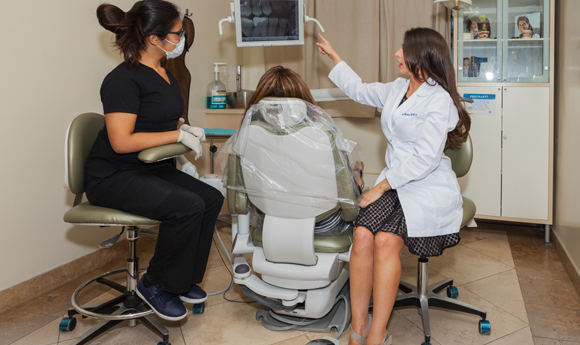Periodontal Disease
Dr. Sally is a top Reviewed Hollywood Dentist
Periodontal Disease
Periodontal disease (also called "gum disease") is an infection of the gums and the bone around the teeth. Periodontal disease is mostly seen in adults but adolescence and even kids can begin to develop it. There are two stages of periodontics disease: gingivitis and periodontitis.
Gingivitis
Periodontal disease begins with gingivitis. Bacteria in your mouth live off of the sugars and food that you eat. If food is not properly cleaned off the teeth then soft plaque begins to accumulate, which the bacteria feed on and in turn produce toxins. Eventually the soft stuff turns into hard tartar. At this stage the gums are very inflamed and bleed easily. This is the stage of GINGIVITIS. If the teeth are properly brushed, flossed, and you have regular dental visits, then you can stop it in its TRACKS!No irreversible bone or tissue damage has happened at this stage.
Periodontitis
Even if you don't notice any symptoms (listed above), you may still have some degree of periodontal disease. Only a dentist can recognize and diagnose the progression of gum disease.Dentists diagnose periodontal disease by checking for gum bleeding, swelling, and pocket depth (the space between the gum and tooth); the deeper the pocket, the more severe the disease. The dentist checks for teeth movement, sensitivity, and proper alignment. The dentist also examines the jawbone to detect any breakdown.
Treatment options depend on the stage of periodontal disease. Gingivitis can be treated with daily brushing and flossing, as well as regular professional cleanings every six months, or sooner. Antibacterial mouthwashes, such as Listerine, also help.
Periodontitis may require deep cleaning of the tooth root below the gums and prescription medications may be taken by mouth or put directly under the gums. If deep scalings don’t fix the problem then gum surgery may be required.
To help prevent periodontal diseases, you should brush and floss every day to remove the bacteria that cause gum disease. See Dr. Kashani at least once a year for professional cleanings, or more frequently if you have any of the warning signs mentioned above.
Brushing eliminates plaque from the surfaces of the teeth, while flossing removes food particles and plaque from in between the teeth and under the gum line. Antibacterial mouth rinses can reduce bacteria that cause plaque and gum disease.
The American Academy of Periodontology says that up to 30% of Americans may be genetically susceptible to gum disease. These people be may be up to six times more likely to develop some form of gum disease.
If anyone in your family has gum disease, it may mean that you are at greater risk. Call (818) 508–7272 today to make an appointment with an experienced dentist to have your teeth and gums examined. Every moment counts with periodontal disease, so don’t delay.


